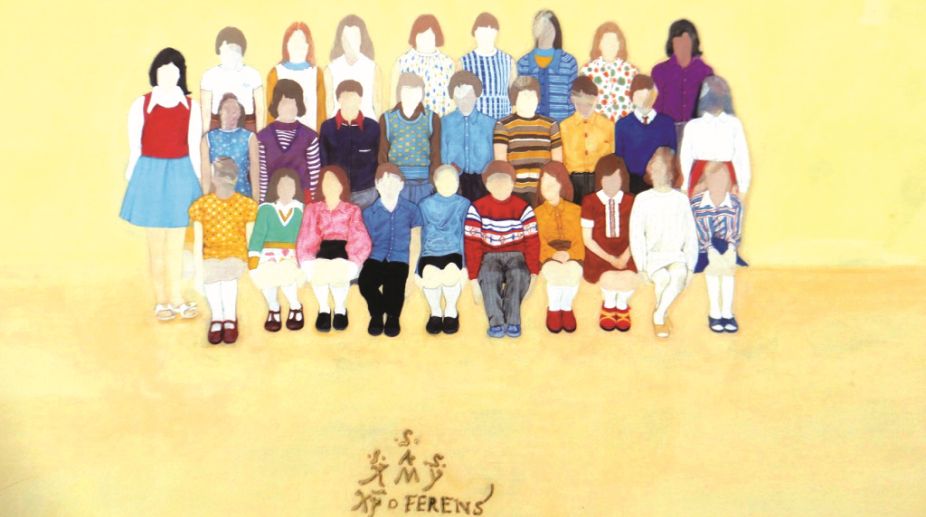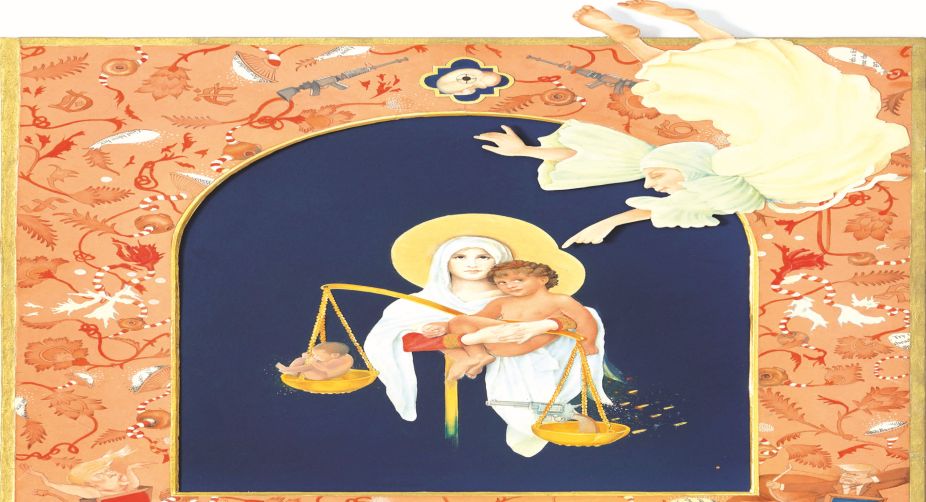Barrackpore railway station turns into canvas before the festival of colours
The initiative has been taken by the Eastern Railway aiming to elevate the aesthetics of the suburban town nestled along the banks of the Hooghly River.
Paintings are an innovative way to convey messages or communicate through visual means. Hashiya, an astonishing art exposition in the Capital, showcased images that could “speak”. A review by Aruna Bhowmick.

Desmond Lazaro Title Classroom I
Scoffing all the way at the countless splattering of mindless “curated” shows, put together by all and sundry, something like a Hashiya at the reborn Gallery Anant, is heart-warming indeed.
Carefully put together, well-explained, text and content carefully aligned, nothing comes as random and incidental about the entire exercise, as it should be with a seriously- curated art exposition featuring Ghulam Sheikh, Saira Wasim, Manisha Gera Waswani and Desmond Lazaro.
Explains curator Kavita Singh about Hashiya, or the Margin, “In about the 16th century, in the courts of Ottoman Turkey, Mughal India and Safavid Persia, the format for miniature paintings underwent a profound change. Instead of being produced as illustrations for manuscripts, miniatures were now made as independent paintings.
Advertisement
The paintings might be portraits, genre scenes, allegories and fantasies, or interpretations of poetry: But whatever the theme, the artist was now working with an unprecedented degree of autonomy.
Earlier, painters would have been under the strict control of the manuscript supervisor or the scribe, who directed the work and ensured it properly reflected the meaning of the text.
Now, artists make paintings that, as independent artworks, communicated through visual, rather than textual, means. This was a shift that marked the growing prestige and greater freedom of artists.
For a long while they had been treated as menial workers; sometimes as ones whose art was on the edge of heresy. Now they were seen as intellectuals whose images could “speak” as eloquently as words.
The paintings thus produced were not meant to remain loose leaves, however, but were gathered into capacious albums called muraqqa ~ meaning “patched”.
These albums assembled a range of artworks between their covers. As readers turned pages of a muraqqa they might see all kinds of wonders ~ a finely detailed painting; a nimble sketch; calligraphy from the blessed hand of a revered master; or a Chinese painting on silk laid down on the paper page.
While there was great skill and artistry in the artworks placed in the album, assembling the album was no less of an artistic task. Those who assembled the album were often artists or litterateurs, who gave careful thought to the work at hand.

Paintings on facing pages were arranged to offer meaningful juxtapositions; calligraphic panels spoke to one another across the sheets; and the overall sequence of the album was carefully worked out for cumulative effect. The album was thus a meta-artwork that massed individual artworks to produce something greater than the sum of its parts.
While the leaves of the album were of uniform size, the things that were pasted on to them might vary greatly in their dimensions, varying the margin, around the items pasted on each page. In the album, this margin, or Hashiya, became another field for play.
One of the greatest Mughal albums ever assembled is the Gulshan Album, begun for Jahangir but probably completed in the reign of Shah Jahan. While in this exquisite album, some norms seem already to be in place for border illustration, in others assembled in Shah Jahan’s time, artists extended and deepened the use of border images, making them relate to the central image in a range of ways: allusive, narrative, theatrical.
Through his iconographic arrangement of two angels hovering above the posthumous Akbar, the artist turns the four borders into a microcosm that reflects the three realms over which the divinely endowed sovereign holds sway: the realm of the beasts, of men and of the heavens! In a superb round-off Kavita Singh says, “What inspiration can we take today, from the Mughal artist, who bent over the album page 400 years ago, and added his own ideas, his own comments, his own appreciation and his own dissent, to the images that he was told he must simply decorate?” Rich food for thought that ~ in every way exemplified by a scholarly yet thrilling exhibition!
Advertisement